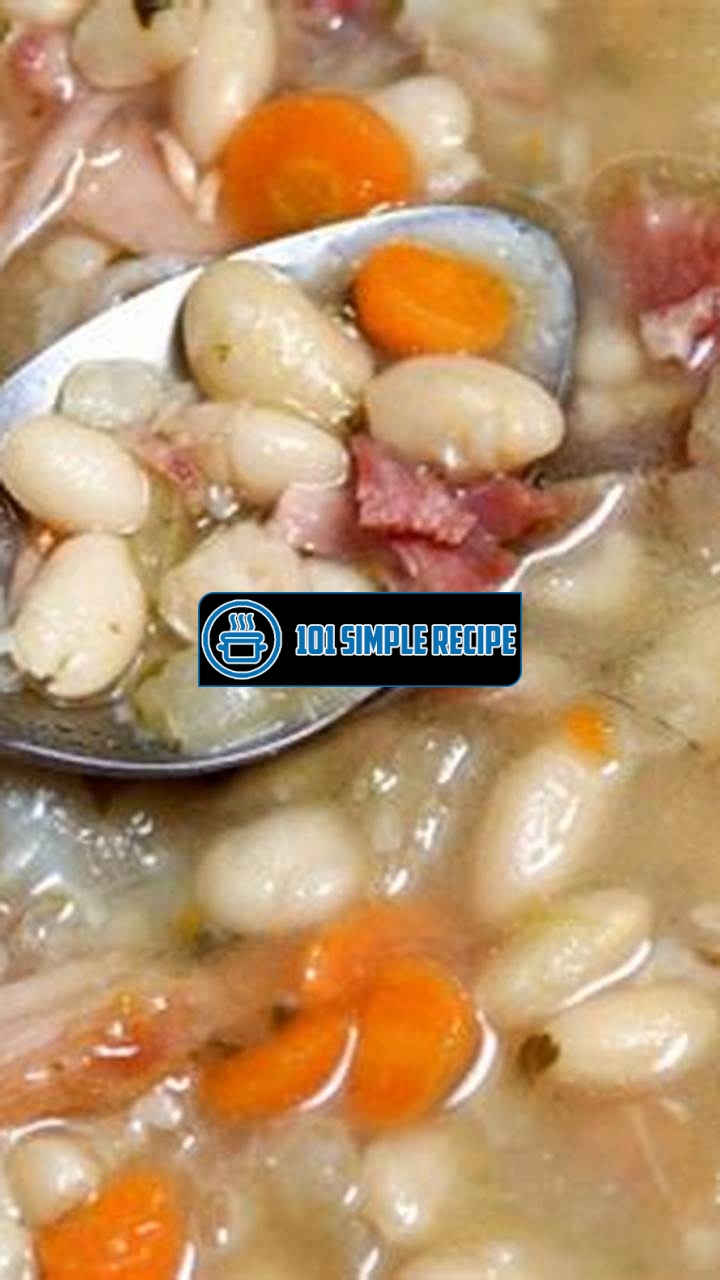Are you ready to tantalize your taste buds and indulge in a savory culinary experience like no other? Look no further than the rich flavors of Old Fashioned Navy Bean Soup. This classic soup recipe has stood the test of time, originating from the hearty meals prepared for sailors in the navy. With its blend of tender navy beans, savory vegetables, and smoky ham hock, each spoonful promises a burst of satisfying flavors. If you’re a soup enthusiast looking to explore a comforting and delicious dish, then this is a must-try recipe! Check out the image below for a mouthwatering visual representation of this delectable soup.

Learn about the rich history and origins of this classic comfort food.
Navy bean soup has a long and fascinating history. It is believed to have originated in the United States, specifically in the region of New England. The navy bean, a small white bean, was a staple food for sailors in the United States Navy during the 19th and early 20th centuries. Due to its high nutrient content, long shelf life, and affordability, navy beans became a popular choice for feeding the sailors on long voyages.
The sailors would often take these beans on their journeys as they were easy to store and cook. They would soak the beans and then cook them with various ingredients found onboard, such as salted pork or beef, onions, and spices. This simple and hearty meal provided sustenance and warmth to the sailors during their long and arduous travels.
As the navy expanded and explored new territories, navy bean soup found its way into other parts of the country. It became a beloved dish in coastal regions and gradually spread to the Midwest and beyond. It became a symbol of American culinary traditions, representing the resourcefulness and ingenuity of the nation’s sailors.
Popularity in American Cuisine
Over time, navy bean soup gained popularity in American cuisine beyond its association with the Navy. It became a favorite comfort food among families and individuals who appreciated its rich flavors and simplicity. The soup’s appeal lies in its ability to blend traditional ingredients to create a delicious and nourishing dish.
Navy bean soup is often enjoyed during the colder months as it provides warmth and comfort. Its hearty nature makes it a satisfying meal on its own or as a side dish. The soup can be prepared in various ways, with each recipe offering a unique twist on the classic recipe. Some variations include the addition of vegetables like carrots and celery, while others incorporate herbs and seasonings for added flavor.
One of the reasons for the enduring popularity of navy bean soup is its affordability. The ingredients are readily available and relatively inexpensive, making it an accessible meal option for many households. Additionally, the versatility of navy beans allows for creative experimentation with flavors and ingredients, making each batch of soup a unique culinary experience.
Traditional Ingredients and Preparation
The traditional preparation of navy bean soup involves soaking the beans overnight to soften them before cooking. This step helps to reduce the cooking time and ensures that the beans are tender and flavorful. Once soaked, the beans are typically simmered in a broth or stock along with other ingredients.
The base for navy bean soup often includes aromatic vegetables such as onions and garlic, which are sautéed before adding the beans and liquid. The liquid can be water or broth, depending on personal preference. Some recipes also call for the addition of diced salted pork or ham hocks to impart smoky flavors and richness to the soup.
The soup is then cooked slowly over low heat, allowing the flavors to meld together and the beans to become tender. This slow cooking process is key to creating a flavorful and delicious navy bean soup. Before serving, the soup can be garnished with fresh herbs, such as parsley or thyme, for an added burst of freshness and aroma.
In summary, navy bean soup has a rich history and has become a beloved dish in American cuisine. Its early roots can be traced back to the United States Navy, where it provided sustenance to sailors during long voyages. Today, navy bean soup continues to be enjoyed for its comforting qualities, affordability, and versatility in flavors and ingredients.
Discover the health benefits that come with incorporating navy bean soup into your diet. Navy bean soup is not only a delicious and comforting dish, but it is also packed with essential nutrients that can contribute to your overall well-being.
Rich Source of Fiber
One of the key nutritional benefits of navy bean soup is its high fiber content. Fiber plays a crucial role in maintaining a healthy digestive system and preventing constipation. It helps to regulate bowel movements and promotes the feeling of fullness, which can aid in weight management. By incorporating navy bean soup into your diet, you can increase your fiber intake and support a healthy digestive system.
In addition to promoting digestive health, the high fiber content in navy bean soup also helps to maintain stable blood sugar levels. Fiber slows down the absorption of carbohydrates, preventing spikes in blood sugar levels and providing a steady release of energy. This can be beneficial for individuals with diabetes or those looking to manage their blood sugar levels.
High Protein Content
Navy bean soup is an excellent source of protein, making it a great option for individuals following a vegetarian or plant-based diet. Protein is essential for building and repairing tissues, promoting muscle growth, and aiding in numerous bodily functions. By incorporating navy bean soup into your meals, you can ensure that you are meeting your protein needs.
The protein found in navy bean soup is also low in fat, making it a healthier alternative to animal-based protein sources. It is a particularly good choice for individuals looking to reduce their saturated fat intake and maintain a healthy heart.
Packed with Essential Vitamins and Minerals
In addition to being a good source of fiber and protein, navy bean soup is also packed with essential vitamins and minerals. It contains significant amounts of folate, magnesium, phosphorus, iron, and potassium, among others. These nutrients play vital roles in maintaining overall health and well-being.
Folate, for example, is important for red blood cell production and DNA synthesis. Magnesium is crucial for maintaining healthy bones and muscles, while phosphorus supports the formation and maintenance of strong bones and teeth. Iron is essential for oxygen transport throughout the body, and potassium is necessary for maintaining proper nerve and muscle function.
The nutritional benefits of navy bean soup make it a valuable addition to a balanced diet. Incorporating this delicious and nutritious soup into your meals can provide you with a variety of health benefits, from improved digestion to increased protein intake and essential nutrient support. So, why not try adding navy bean soup to your menu and enjoy the delicious flavors while nourishing your body?
When it comes to preparing a flavorful and delicious old fashioned navy bean soup, there are a few expert tips and tricks that can help you achieve the best results every time. Whether you are a seasoned cook or a beginner in the kitchen, these guidelines will ensure that your navy bean soup is always a hit. From soaking and preparing the beans to choosing the perfect seasoning combinations and determining the cooking method, here’s everything you need to know to create a mouthwatering bowl of navy bean soup.
Soaking and Preparing the Beans
One of the most important steps in cooking old fashioned navy bean soup is soaking the beans. Soaking helps to soften the beans and reduce their cooking time. To soak the beans, start by rinsing them thoroughly and removing any debris or foreign objects. Then, place the beans in a large bowl and cover them with enough water. Let the beans soak overnight or for at least 6-8 hours. Once the beans have soaked, drain and rinse them again before using them in your soup.
Now that your beans are ready, it’s time to prepare them for the soup. In a large pot, add the soaked beans along with enough water to cover them. Bring the water to a boil and let the beans cook for about 10 minutes. Then, reduce the heat to a simmer and cook the beans for another 1-2 hours, or until they are tender. Skim off any foam or impurities that rise to the surface during cooking. Once the beans are cooked, drain them and set them aside while you prepare the other ingredients.
Flavorful Seasoning Combinations
Now that the beans are prepared, it’s time to enhance their flavor with the perfect seasoning combinations. Navy bean soup pairs well with a variety of seasonings, including herbs, spices, and aromatics. For a classic and traditional flavor, consider adding bay leaves, thyme, and garlic to your soup. You can also experiment with other seasonings such as smoked paprika, cumin, or chili powder to give your soup a unique twist.
In addition to herbs and spices, you can also add vegetables and meats to your navy bean soup for additional flavor. Popular options include onions, carrots, celery, ham hocks, or bacon. These ingredients not only add depth and richness to the soup but also provide a satisfying texture. Consider sautéing the vegetables and meats before adding them to the soup for extra flavor.
Slow Cooker vs Stovetop Method
When it comes to cooking old fashioned navy bean soup, you have two main options: the slow cooker method and the stovetop method. Both methods have their advantages and can result in a delicious bowl of soup.
Slow Cooker Method: The slow cooker method is ideal for those who prefer a hands-off approach to cooking. Simply combine all the ingredients in the slow cooker and set it to low heat. Let the soup cook for 6-8 hours or until the beans are tender. This method allows the flavors to develop slowly and creates a rich and hearty soup.
Stovetop Method: The stovetop method is perfect for those who want to enjoy a warm bowl of soup in a shorter amount of time. Cook the soup on the stovetop over medium-low heat for about 1-2 hours, or until the beans are tender. This method requires more attention and stirring, but it allows you to adjust the seasonings and flavors as you go.
Whether you choose the slow cooker method or the stovetop method, make sure to taste and adjust the seasoning before serving. You can add more salt, pepper, or other seasonings to suit your palate. Serve your old fashioned navy bean soup hot with crusty bread or cornbread for a satisfying and comforting meal.
Serving Suggestions and Pairings
When it comes to serving and enhancing the flavors of old fashioned navy bean soup, there are plenty of creative ways to make your meal even more enjoyable. Whether you’re hosting a dinner party or simply cooking for yourself, these suggestions will elevate your navy bean soup to a whole new level.
Accompaniments and Side Dishes
To complement the rich flavors of navy bean soup, consider serving it with a variety of accompaniments and side dishes. These additions will not only provide contrasting textures but also enhance the overall dining experience. Here are a few ideas to get you started:
- Crusty Bread: Nothing beats a slice of warm, crusty bread to soak up the flavorful broth of navy bean soup.
- Garlic Butter: Spread some garlic butter on your bread for an extra burst of flavor.
- Chopped Fresh Herbs: Sprinkle some fresh herbs like parsley or thyme over the soup for a touch of freshness.
- Grated Cheese: Top your bowl of navy bean soup with a generous sprinkling of grated cheese, such as Parmesan or cheddar.
- Crumbled Bacon: For a savory twist, crumble some crispy bacon on top of your soup.
Variations and Additions
If you’re looking to add more depth and variety to your navy bean soup, there are several delicious variations and additions you can try. These options will allow you to customize the soup according to your taste preferences:
- Ham Hock: Adding a ham hock to the soup while it simmers will infuse it with smoky and savory flavors.
- Vegetables: Toss in some diced carrots, celery, and onions for added texture and nutritional value.
- Spices and Herbs: Experiment with different spices and herbs like cumin, bay leaves, or rosemary to create unique flavor profiles.
- Tomato Paste: Stir in a spoonful of tomato paste to give your navy bean soup a tangy and slightly acidic taste.
- Hot Sauce: If you like a bit of heat, drizzle some hot sauce into your bowl for a spicy kick.
Pairing with Wines and Beverages
No meal is complete without the perfect wine or beverage pairing. When it comes to navy bean soup, there are a few options that complement its flavors exceptionally well:
- Chardonnay: The buttery and oak flavors of a Chardonnay pair beautifully with the creamy and rich navy bean soup.
- Sauvignon Blanc: The crisp and citrusy notes of a Sauvignon Blanc provide a refreshing contrast to the hearty flavors of the soup.
- Amber Ale: If you prefer beer over wine, an amber ale with its malty and caramel undertones will complement the soup nicely.
- Iced Tea: For a non-alcoholic option, a glass of iced tea, either sweetened or unsweetened, will provide a refreshing accompaniment.
By exploring these serving suggestions and pairings, you can elevate your old fashioned navy bean soup into a complete and satisfying meal. Get creative with your accompaniments, experiment with variations and additions, and find the perfect beverage to enhance the flavors. Enjoy the richness and depth of flavors in every spoonful!
Historical Significance and Cultural Impact
The rich flavors of old fashioned navy bean soup have a long and storied history in various cultures and traditions around the world. These humble beans, also known as haricot beans, have been a staple food for centuries and have played a significant role in shaping culinary traditions and cultural practices.
Symbolism and Traditions
In many cultures, navy bean soup carries deep symbolism and is often associated with warmth, comfort, and nourishment. It has become a symbol of hospitality and community, as it is commonly served as a welcoming dish during gatherings and celebrations. The slow cooking process and the aromatic herbs and spices used to prepare the soup create a cozy ambiance and evoke a sense of tradition and togetherness.
Moreover, navy bean soup is often linked to religious rituals and practices. For instance, in some cultures, it is customary to serve the soup during funeral gatherings as a way to provide solace and support to the bereaved. The simplicity and heartiness of the soup are believed to offer both physical and emotional sustenance.
Navy bean soup has found its way onto the tables of diverse cultures, each adding their unique twist to the classic recipe. In the United States, it is a traditional dish enjoyed especially during the cold winter months. The soup is often prepared with smoked ham hocks or bacon, giving it a smoky and savory flavor. It is commonly served with cornbread on the side, creating a satisfying and wholesome meal.
In Greek cuisine, a variation of navy bean soup called “fasolada” holds great cultural significance. Fasolada is a vegetarian version of the soup that incorporates tomatoes, carrots, celery, and a medley of aromatic herbs. It is often considered the national dish of Greece and is enjoyed throughout the year, particularly on Saint Basil’s Day, a traditional holiday.
Influence on Modern Culinary Trends
The influence of old fashioned navy bean soup can also be observed in modern culinary trends. With the growing emphasis on healthy eating and plant-based diets, navy beans have gained popularity as a nutritious and versatile ingredient. Chefs and home cooks alike are incorporating navy beans into a wide range of dishes, from salads and stews to dips and spreads.
Furthermore, the slow cooking method traditionally used to prepare navy bean soup has paved the way for the resurgence of slow cooker and instant pot recipes. These convenient kitchen appliances allow busy individuals to effortlessly recreate the flavors and textures of traditional navy bean soup in a fraction of the time.
In conclusion, the historical significance and cultural impact of old fashioned navy bean soup are undeniable. Its symbolism, traditions, and influence on modern culinary trends highlight the enduring popularity and versatility of this humble bean soup. So why not embrace the rich flavors and satisfying warmth by trying out a bowl of navy bean soup yourself?
Frequently Asked Questions
Here are some common questions about old fashioned navy bean soup:
| No. | Questions | Answers |
|---|---|---|
| 1. | What are the main ingredients in old fashioned navy bean soup? | Old fashioned navy bean soup typically includes navy beans, onions, carrots, celery, garlic, ham hocks, and various spices and seasonings. |
| 2. | How long does it take to cook old fashioned navy bean soup? | The cooking time for old fashioned navy bean soup is approximately 2 to 3 hours, depending on the desired tenderness of the beans. |
| 3. | Can I make old fashioned navy bean soup vegetarian? | Yes, you can make a vegetarian version of old fashioned navy bean soup by omitting the ham hocks and using vegetable broth instead of chicken broth. |
| 4. | Can I freeze old fashioned navy bean soup? | Yes, you can freeze old fashioned navy bean soup. Allow it to cool completely before transferring it to a freezer-safe container. It can be stored in the freezer for up to 3 months. |
| 5. | What are some optional toppings for old fashioned navy bean soup? | Some optional toppings for old fashioned navy bean soup include sour cream, chopped green onions, shredded cheese, or crumbled bacon. |
| 6. | Can I use canned navy beans instead of dried beans? | Yes, you can use canned navy beans instead of dried beans. Simply rinse and drain the canned beans before adding them to the soup. |
Closing Thoughts
Thank you for taking the time to read about old fashioned navy bean soup. We hope you found this article informative and inspiring for your next home-cooked meal. If you have any further questions or would like to share your own experiences with this classic dish, please feel free to leave a comment. Visit us again for more delicious recipes and culinary inspiration. Happy cooking!
Jump to Recipe

A hearty and comforting soup made with tender navy beans, vegetables, and savory seasonings.
- 1 pound dried navy beans
- 1 onion (chopped)
- 2 carrots (diced)
- 2 celery stalks (chopped)
- 3 cloves garlic (minced)
- 2 ham hocks
- 8 cups chicken broth
- 1 bay leaf
- 1 teaspoon dried thyme
- Salt and pepper (to taste)
- Rinse the dried navy beans and soak them overnight in a large bowl of water. Drain before using.
- In a large pot or Dutch oven, heat some oil over medium heat. Add the chopped onion, diced carrots, chopped celery, and minced garlic. Sauté until the vegetables are softened.
- Add the soaked navy beans, ham hocks, chicken broth, bay leaf, dried thyme, salt, and pepper to the pot. Bring to a boil, then reduce heat and simmer for 2 to 3 hours, or until the beans are tender.
- Remove the bay leaf and ham hocks from the pot. Discard the bay leaf and shred the meat from the ham hocks. Return the shredded meat to the pot and stir to combine.
- Taste and adjust seasonings as needed. Serve hot and enjoy!






